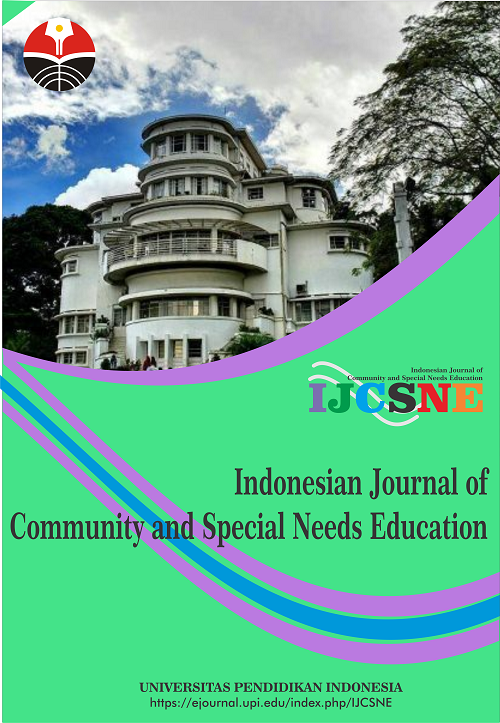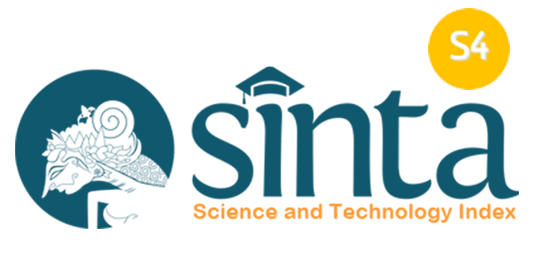The Drilling Method Application Using Abacus to Arithmetic Operations Skills in Student with Hearing Impairment at Special School
Abstract
Keywords
Full Text:
PDFReferences
Çelik, H. C. (2018). The effects of activity based learning on sixth grade students’ achievement and attitudes towards mathematics activities. EURASIA Journal of Mathematics, Science and Technology Education, 14(5), 1963-1977.
Chotimah, S., Bernard, M., and Wulandari, S. M. (2018). Contextual approach using VBA learning media to improve students’ mathematical displacement and disposition ability. IOP Publishing. In Journal of Physics: Conference Series, 948(1), 012025.
Fitri, R., and Yogica, R. (2018). Effectiveness of concept-based learning model, drawing and drill methods to improve student’s ability to understand concepts and high-level thinking in animal development course. IOP Publishing. In Journal of Physics: Conference Series, 1116 (5), 052040.
Fuentes-Cabrera, A., Parra-González, M. E., López-Belmonte, J., and Segura-Robles, A. (2020). Learning mathematics with emerging methodologies—The escape room as a case study. Mathematics, 8(9), 1586.
Gan, C., Cao, W., Wu, M., Liu, K. Z., Chen, X., Hu, Y., and Ning, F. (2019). Two-level intelligent modeling method for the rate of penetration in complex geological drilling process. Applied Soft Computing, 80 (2019), 592-602.
Hidayat, D. S., Rahmat, C., Fattah, N., Rochyadi, E., Nandiyanto, A. B. D., and Maryanti, R. (2020). Understanding Archimedes law: What the best teaching strategies for vocational high school students with hearing impairment. Journal of Technical Education and Training, 12(1), 229-237.
Holman, D., Lynch, R., and Reeves, A. (2018). How do health behaviour interventions take account of social context? A literature trend and co-citation analysis. Health, 22(4), 389-410.
Jacquet, C., Chan-Yu-Kin, J., Sharma, A., Argenson, J. N., Parratte, S., and Ollivier, M. (2019). “More accurate correction using “patient-specific” cutting guides in opening wedge distal femur varization osteotomies. International orthopaedics, 43(10), 2285-2291.
Karnes, J., Barwasser, A., and Grünke, M. (2021). The Effects of a Math Racetracks Intervention on the Single-Digit Multiplication Facts Fluency of Four Struggling Elementary School Students. Insights into Learning Disabilities, 18(1), 53-77.
Kumar, R., Hynes, N. R. J., Pruncu, C. I., and Sujana, J. A. J. (2019). Multi-objective optimization of green technology thermal drilling process using grey-fuzzy logic method. Journal of Cleaner Production, 236(2019), 117711.
Kunwar, R. (2020). Math mania: meaning, problems and ways of effective teaching and learning mathematics at basic level education in Nepal. International Journal of Science and Research (IJSR).8(9), 1136-1141.
Maryanti, R. (2021). Assessment of mathematical abilities of students with intellectual disabilities during the COVID-19 pandemic. Indonesian Journal of Community and Special Needs Education, 1(2), 47-52.
Maryanti, R.., Hufad, A. , Nandiyanto, A. B. D., and Tukimin, S. (2021). Teaching the corrosion of iron particles in saline water to students with special needs. Journal of Engineering Science and Technology, 16(1), 601-611.
Noland, R. L., Wells, M. S., Sheaffer, C. C., Baker, J. M., Martinson, K. L., and Coulter, J. A. (2018). Establishment and function of cover crops interseeded into corn. Crop Science, 58(2), 863-873.
Papadakis, S., Kalogiannakis, M., and Zaranis, N. (2018). The effectiveness of computer and tablet assisted intervention in early childhood students’ understanding of numbers. An empirical study conducted in Greece. Education and Information Technologies, 23(5), 1849-1871.
Polydoros, G. (2021). Teaching and learning mathematics with mobile devices. Journal of Research and Opinion, 8(7), 2978-2985.
Rahadyan, A., Gardenia, N., and Hidayah, M. (2020). Development Of Skills Of Teachers And Parents In Tk Qurrota A’yun Using Sempoa. Jurnal Masyarakat Mandiri, 4(3), 415-423.
Ridgway, J. (2016). Implications of the data revolution for statistics education. International Statistical Review, 84(3), 528-549.
Rusyani, E., Maryanti, R., Muktiarni, M., and Nandiyanto, A. B. D. (2021). Teaching On The Concept Of Energy To Students With Hearing Impairment: Changes Of Electrical Energy To Light And Heat. Journal of Engineering Science and Technology, 16(3), 2502-2517.
Rusyani, E., Maryanti, R., Utami, Y. T., and Pratama, T. Y. (2021). Teaching Science In Plant Structure For Student With Hearing Impairments. Journal of Engineering Science and Technology, 16(2), 1577-1587.
Supriatna, I., Asmahasanah, S., Rachmadtullah, R., and Asdar, A. K. (2019). The effect of learning methods and self-regulation on problem-solving ability of mathematics in elementary school. IOP Publishing. In Journal of Physics: Conference Series, 1175(1), 012139.
Susetyo, B., Maryanti, R., and Siswaningsih, W. (2021). Students With Hearing Impairments’comprehension Level Towards The Exam Questions Of Natural Science Lessons. Journal of Engineering Science and Technology, 16(2), 1825-1836.
Widodo, S. A. (2018). Selection of Learning Media Mathematics for Junior School Students. Turkish Online Journal of Educational Technology-TOJET, 17(1), 154-160.
DOI: https://doi.org/10.17509/ijcsne.v2i1.37133
Refbacks
- There are currently no refbacks.
Copyright (c) 2021 Universitas Pendidikan Indonesia

This work is licensed under a Creative Commons Attribution-ShareAlike 4.0 International License.















